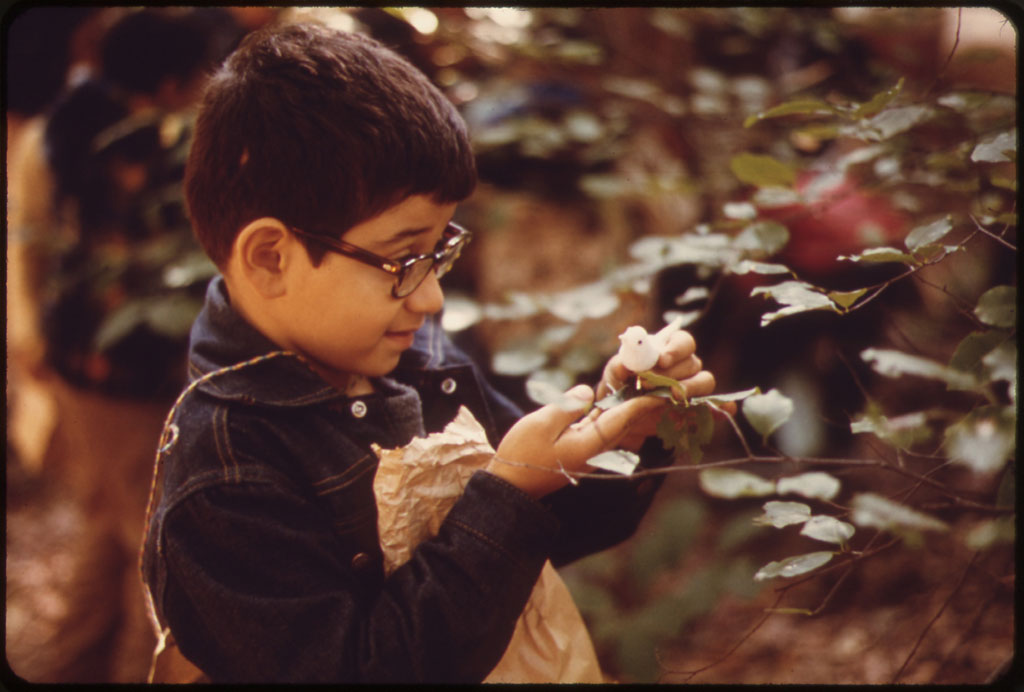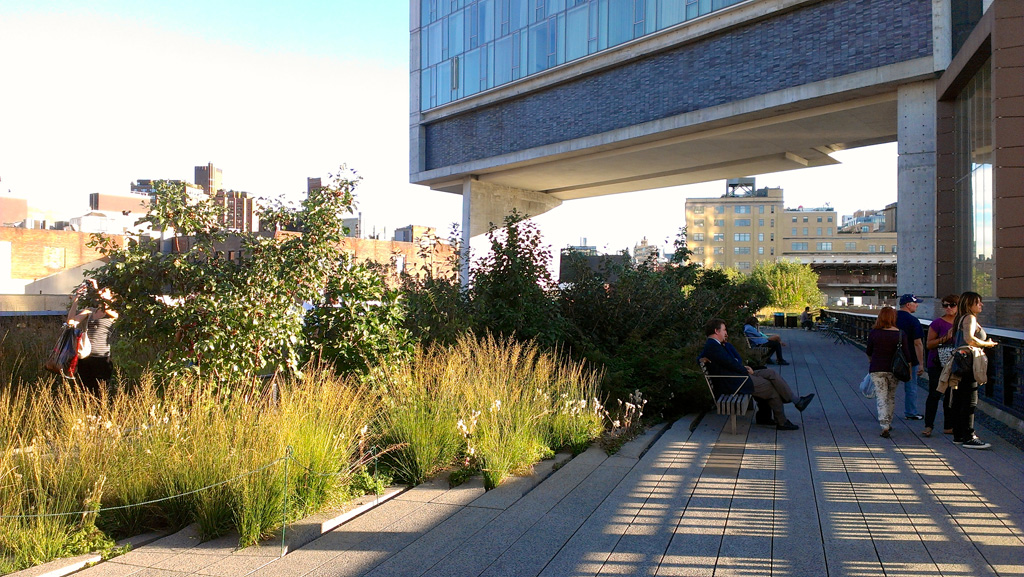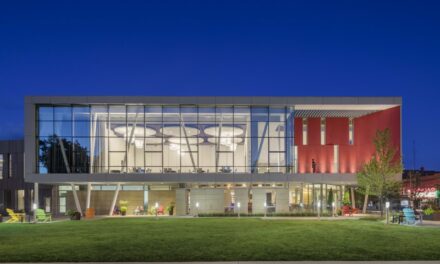In today’s society, sectors across industry are reaping the economic benefits of biophilic design. By examining five of these sectors—workplaces, healthcare, retail stores, schools, and communities—we can begin to understand the fiscal implications of biophilic design across the economy. The numbers and percentages presented reflect powerful evidence that design and planning strategies informed by nature can lead to positive impacts on human health, child development, community safety, and worker satisfaction. These effects translate directly to increased profits.
Better Futures for Schoolchildren – Biophilic Design in Educational Settings
Beyond cutting energy costs in schools, the education sector seems like an unlikely place to achieve major financial savings. The United States spends over $631 billion on elementary and secondary education annually, with the cost of K-12 education averaging $12,509 per student (US Department of Education, 2017). It is important to consider investments in the physical classrooms and schools that students learn in to ensure that every dollar spent contributes to the educational success of our students. Current studies show that classrooms designed with biophilic elements can improve test scores, support health, and increase learning rates. Studies also indicate that allowing children to play and learn in nature can provide benefits like mental restoration, better behavior, and enhanced focus.
The classroom is perhaps the most influential environment outside the home where young students experience rapid brain development and expansion in social skills. It is critical to incorporate as many positive attributes as possible into these learning environments. In a 1996 study on academic outcomes, researchers found an increase in attendance (between 3.2 to 3.8 days more per year) in schools with south-facing roof monitors that allowed controlled, optimal daylight into classrooms compared with insufficiently daylight schools. The cumulative value for three days of school for the estimated 633 students in the school district amounted to $126,283 in tax dollars (Nicklas & Bailey, 1996).

Childhood Development – Nature is critical in children’s formative years. Studies show that nature provides children with a buffer against life’s stresses, and enables them to form social bonds. A study of daylighting in schools also showed that children learn 20-26% faster in natural daylight. – Wells & Evans, 2003; Heschong, 2003
Photo courtesy of the US EPA
Academic Outcomes & Student Performance
Biophilic principles can also influence student performance in the classroom. Across 17 studies from 1934-1997, experts agreed that good daylighting “improves tests scores, reduces off-task behavior, and plays a significant role in the achievement of students” (Kats, 2006). In a 1996 daylighting study, test scores increased between 5-14%. In the same school district, a concurrent 17% drop in test scores from pupils in the windowless mobile classrooms provides a strong indicator of this link between improved test scores and daylit classrooms (Nicklas & Bailey, 1996). In a different study, students in the the Capistrano, CA school district, students in classrooms with the most daylighting tested 7-18% higher than those with the least. Furthermore, these students also demonstrated a 20-26% faster learning rate (Heschong, 1999). Students in classrooms with access to both daylight and views showed the greatest improvement.
The district’s small investment in the facilities to improve daylighting yielded test scores that increased dramatically compared to state averages. The facilities investment also saved on long-term operating costs through reduced energy consumption. The study estimates that the strategies of biophilia have statistically increased test scores by 5-18% and can continue to do so in schools across the country (Heschong, 1999).
Greater exposure to nature has also been shown to improve overall cognitive development. In a study across 36 elementary schools, researchers tracked cognitive development over twelve months against known developmental outcomes (Dadvand et al., 2015). The study, measuring working memory, superior working memory, and attention testing, concluded a compounding improvement in cognitive development for those students with the greatest exposure to nature, measured using Normalized Difference Vegetation Index at home, on the commute to school, and around schools. The wide-ranging effects of improved childhood development cannot be overstated because these formative years influence an individual’s economic and social outcomes later in life.
Research on the effects of including nature in the classroom is not meant to diminish the importance of educational improvements relating to the quality of curricula and school resources themselves. Instead, the research shows that an important factor in the quality of a school environment is a child’s daily exposure to nature. Given this type of exposure’s well-documented impact on academic performance, school systems should consider this as an another viable option to improve children’s academic performance. Integrating biophilia into academic and institutional building design standards while simultaneously investing in stronger school curricula is an effective and holistic way to ensure students have the most productive environment possible.
Additional Measures of Educational Success
According to numerous sources, including the National Center of Secondary Education and Transition (NCSET), an improved school experience may increase the rate of school retention as students move through the education system, which in turn has significant economic implications (Lehr et al., 2004). One approach to improving the schooling experience, greater exposure to nature, had a significant positive association with graduation rate and students’ plans to attend a four-year-college (Matsuoka, 2010). The NCSET estimates that students who do not complete high school will earn $9,984 less per year than high school graduates, and $33,956 less per year than four-year-college graduates (Bureau of Labor Statistics, 2017). Furthermore, the Alliance for Excellent Education estimates that, had the class of 2015 reached a 90% graduation rate (actual graduation rate was 83.2%), the national economy would have benefited from an additional $5.7 billion in GDP by the midpoint of those students’ careers. (Alliance for Excellent Education, 2018).
Stress can also affect children’s experience at school significantly. Various studies find the adolescent brain to be especially sensitive to stress, with potential outcomes ranging from altered brain development to cognitive, emotional and systemic disorders (McEwen, 2011; Lupien et al., 2009). Moreover, the effects of childhood stress often don’t emerge until adulthood (Lupien et al., 2009). Improving schools’ design and curricula, often regarded as the most stressful part of adolescent life, can have significant impacts on the wellbeing and cognitive performance of students. One study of rural school children around age 9 and living in upstate New York found that the impact of life stress among the 337 children in the study was significantly less in children with high levels of nature nearby compared to those with comparatively low levels of nature nearby (Wells & Evans, 2003). This correlation is reinforced by a 2016 study that found a significant increase in students’ recovery from stressful experiences when they were in classrooms with views of nature as opposed to views of built spaces and in windowless rooms (Li & Sullivan, 2016).
Researchers have also documented a correlation between an increased connection with nature and classroom engagement and attention spans. The same 2016 study by Li and Sullivan found a 13% increase in student attentional function in rooms with views of nature as opposed to views of built space and windowless rooms. In another study of 300 students in the US midwest, classroom engagement significantly improved after a lesson in nature when compared to a standard classroom-based lesson (Kuo, Browning & Penner, 2018). Among other things, the researchers found that teachers had to redirect students’ attention half as frequently, allowing them to teach uninterrupted for twice as long. The improved classroom engagement remained constant throughout the entire 5-week study period.
These studies show that nature can serve as as a supportive environment for childhood development. Nature supplies social support for children as they interact with others. When children become engaged in nature, their neural mechanisms are allowed to rest and recover. Attentional restoration is critical for children. Without it, children will increasingly respond to distracting stimuli, experience greater loss of focus, and have difficulty managing daily tasks (Wells & Evans, 2003).
From Theory to Practice
Outdoor learning is increasingly being recognized for its benefits to students’ information retention, attentional functioning, social development, and ability to buffer psychological stressors (e.g. Kuo, Browning & Penner, 2018). What the Danes call udeskole, or curriculum-based outdoor learning, has seen increasing adoption and standardization across Europe. One study found 14% of Danish teachers practices udeskole on a weekly or bi-weekly basis (Bentsen & Jensen, 2012). Not coincidentally, Nordic countries, often considered the champion of outdoor learning in schools, consistently rank among the highest on standardized test scores and overall student outcomes (PISA, 2015).
Such practices are beginning to take root in American schools as well, with over 250 nature preschools and kindergartens nationwide -an increase of 66% in just one year (North American Association for Environmental Education, 2017). The estimated 10,000 children enrolled in these programs spend around three quarters of their time outdoors. One such “nature preschool,” “Elements” in the Lower east side of New York City, emphasizes exploration, self-discovery, motor skill development, and appreciation for nature through a variety of indoor and outdoor spaces (Elements Nature Preschool, 2018).
Colleges, too, are turning to biophilic design to address increasingly prevalent symptoms of school-induced stress on students. The Windhover Center at Stanford University, completed in 2014, promotes contemplation, refuge, and recovery for the Stanford community. The building’s design creates a powerful interplay of artwork and the surrounding landscape, allowing individuals to “offset the personal cost that can be entailed by students, faculty and staff striving to reach the pinnacle of their fields” (Stanford University, n.d.).
It is time to start relying on our affinity to nature to design schools that use biophilic standards to complement the efforts being made to improve educational curricula. The lessons from the healthcare and other sectors show that their biophilic standards decrease costs while improving outcomes. Keeping children in school until they graduate and helping them to focus their attention on learning has immense benefits to society at large.
“The Economics of Biophilia” is a six-part republication of “The Economics of Biophilic Design” by Terrapin Bright Green. As a series, each section explores one of five economic indicators as it relates to biophilic design: workplace, healthcare, education, retail, and community.
Work References:
Alliance for Excellent Education. (2018). “High School Graduation Rates and Their Effect on the American Economy.” all4ed.org.
Bentsen, P., & Jensen, F.S. (2012). The nature of udeskole: Outdoor learning theory and practice in Danish schools. Journal of Adventure Education & Outdoor Learning, 12(3), 199-219
Bureau of Labor Statistics. (2017). Current Population Survey. Median weekly earnings (in dollars) and unemployment rate (in percent) by educational attainment, 2017. BLS.gov
Dadvand, P., Nieuwenhuijsen, M.J., Esnaola, M., Forns, J., Basagaña, X., Alvarez-Pedrerol, M., Rivas, I., López-Vicentea, M., De Castro Pascual, M., Su, J., Jerrett, M., Querol, X., & Sunyer, J. (2015). Green spaces and cognitive development in primary schoolchildren. Proceedings of the National Academy of Sciences of the United States of America, 112(26), 7937-7942.
Elements Nature Preschool. 2018. Curriculum. http://elementspreschool.com/curriculum/
Heschong, L., Heschong Mahone Group. (1999). “Daylighting in Schools: An Investigation into the Relationship Between Daylighting and Human Performance.” California Energy Commission: Pacific Gas and Electric Company. Fair Oaks, California.
Kats, G. (2006). “Greening America’s Schools – Cost and Benefits”. Capital E Report. The US Green Building Council.
Kuo, M., Browning, M.H.E.M., & Penner, M.L. (2018). Do lessons in nature boost subsequent classroom engagement? Refueling students in flighting. Frontiers in Psychology, 8, 2253.
Lehr, C.A., Johnson, D.R., Bremer, C.D., Cosio, A.,Thompson, M. (2004). “Increasing Rates of School Completion: Moving from Policy and Research to Practice.” National Center on Secondary Education and Transition. Full Report.
Li, D., & Sullivan, W.C. (2016). Impact of views to school landscapes on recovery from stress and mental fatigue. Landscape and Urban Planning, 148, 149-158.
Lupien, S.J., McEwen, B.S., Gunnar, M.R., & Heim, C. (2009). Effects of stress throughout the lifespan on the brain, behaviour and cognition. Nature Reviews: Neuroscience, 10. Macmillan Publishers Limited.
Matsuoka, R.H. (2010). Student performance and high school landscapes: Examining the links. Landscape and Urban Planning, 97(4), 273-282.
McEwen, B.S. (2011). Effects of stress on the developing brain. Cerebrum, 14.
Niklas, M.H., & Bailey, G.B. (1996). “Student Performance in Daylit Schools.” Innovative Design. Raleigh, North Carolina.
North American Association for Environmental Education (NAAEE). (2017). Nature preschools and forest kindergartens: 2017 national survey. Washington, DC: NAAEE.
PISA. (2015). PISA 2015 Results in focus. Organisation for Economic Co-operation and Development.
Stanford University. (n.d.). Windhover: About. Retrieved from https://windhover.stanford.edu/about-0.
U.S. Department of Education, National Center for Education Statistics. (2017). The Condition of Education 2017 (NCES 2017-144), Public School Expenditures. https://nces.ed.gov/fastfacts/display.asp?id=66
Wells, N.M., & Evans, G.W. (2003). Nearby Nature: A Buffer of Life Stress Among Rural Children”. Environment and Behavior, 35(3), 311–330.





